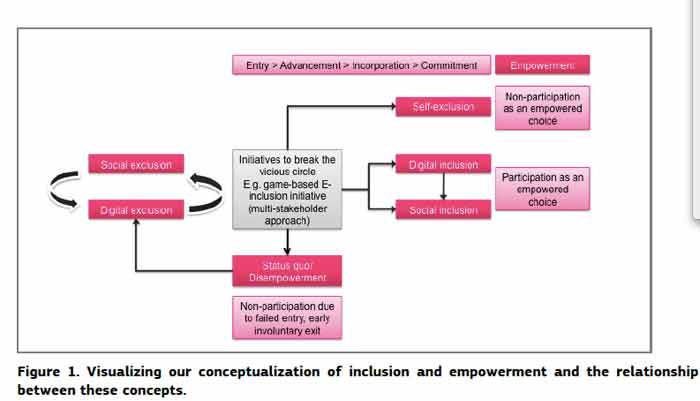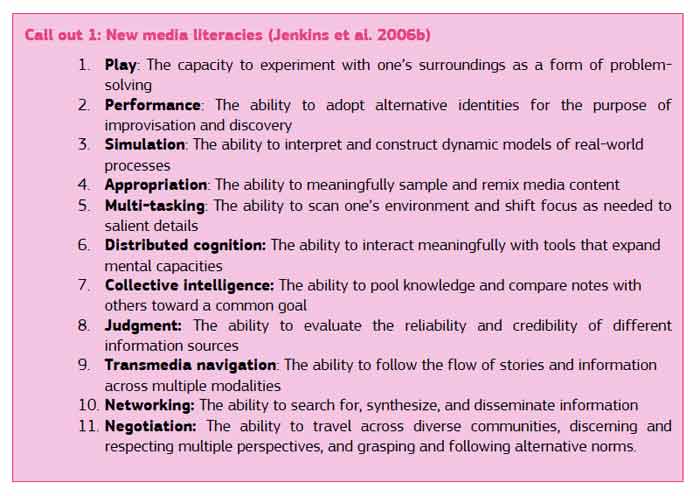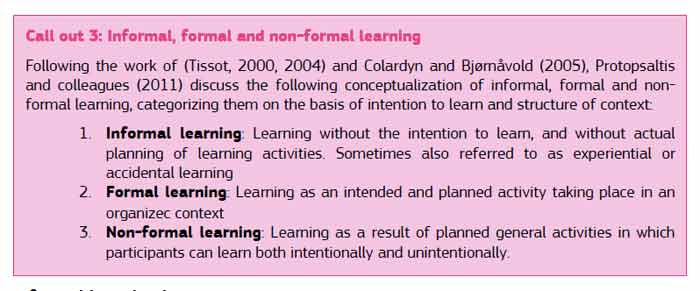Raymond Morel
4003 days ago
"
This report presents the 'state of play' of knowledge of how digital games can work as empowerment tools to support social inclusion processes and policy. The report brings together for the first time a review of theoretical and empirical research in a variety of disciplines, especially from learning, social inclusion, e-inclusion and innovation studies to build a framework to help understanding of the potential of games for inclusion and empowerment. It uses this framework to analyse seven welldocumented case studies from across the spectrum of digital games for empowerment and inclusion to understand between the factors contributing to their success or failure. It draws conclusions as to the principal challenges, identifies knowledge gaps, and recommends potential action by stakeholders to address these challenges."
" In Europe today an estimated 110 million people are at risk of social exclusion. This
presents society, entrepreneurs and policy makers with a challenge that calls for social
innovation of all types to tackle low skills, unemployment, discrimination, barriers to
disabled people, poor health and other factors associated with social exclusion.
The Information Society Unit at the JRC IPTS leads research to explore and show when and
how information, communication and media technologies can both shape the conditions of
social exclusion, and offer pathways to social inclusion, particularly when used by social
inclusion actors and intermediaries. Previous research has demonstrated how 'conventional'
technologies such as the PC and internet applications can support socio-economic inclusion
processes for populations at risk of exclusion such as migrants, youth at risk, and the
elderly and their carers. In recent years there has been growth of research and commercial
activity in the use of digital games for non-leisure activities and the promise of
gamification as a building block of social innovation promoted DG CNCT and the JRC-IPTS
to launch a study, Digital Games for Empowerment and Inclusion (DGEI). The goal was to
better understanding of how this hugely popular media form is being applied to issues of
concern for social inclusion policy, and inform future policy options.
The main output of the study is the JRC Scientific and Policy report " The Potential of Digital
Games for Empowerment and Social Inclusion of Groups at Risk of Social and Economic
Exclusion: Evidence and Opportunity for Policy. It is accompanied by two JRC technical
reports, of which this is one. This report presents a detailed literature review of the current
state of research knowledge and original empirical research practice. It addresses not only
the way that games work, but explores the conditions under which games are used in
practice, and the challenges facing the production of special-purpose games.
It is hoped that this report will support games and social inclusion researchers and
practitioners, policy makers, and other stakeholders in their work to exploit the world of
game development and use in to forward both social goals and research and business projects."



 Table of Contents
Table of Contents
ACKNOWLEDGEMENTS ................................................................. 1
PREFACE ........................................................ 3
INTRODUCTION .................................................. 7
POLICY CONTEXT ...................................................................................... 7
SCOPE ................................................................................................ 8
METHODOLOGICAL APPROACH ................................................................... 9
1. KEY CONCEPTS .................................... 13
1.1. INCLUSION .................................................................................................... 13
1.2. EMPOWERMENT .................................................... 20
1.3. GAMING AND PLAY ..................................................................................... 25
1.4. DIGITAL GAMES FOR EMPOWERMENT AND INCLUSION ........................... 29
2. INSIGHTS FROM RESEARCH AND PRACTICE ................. 35
2.1. LEARNING AND PARTICIPATION IN GAMES: 3 APPROACHES ................. 35
2.2. MOTIVATION TO PLAY, PARTICIPATE, LEARN ................................................. 50
2.3. APPLICATION DOMAINS .................................................................................... 57
2.4. FROM GAME DEVELOPMENT TO REACHING THE AUDIENCE .............. 62
2.5. ADOPTION, IMPLEMENTATION AND USAGE ............................................................... 71
2.6. EXPLORING THE IMPACT OF DIGITAL GAMES .......................................................... 89
2.7. KNOWLEDGE GAPS ................................................................................................ 95
3. CASE STUDIES .................................................................................... 97
3.1 POVERTY IS NOT A GAME (PING) ............................................................................. 97
3.2 INLIVING ............................................................................................................ 105
3.3 AT-RISK ............................................................................................................................ 111
3.4 CHOICES AND VOICES .............................................................................................. 117
3.5 STARBRIGHT WORLD ......................................................................................................... 123
3.6 GAMES LEARNING SOCIETY (GLS) – CIVILIZATION & CIVWORLD ................ 129
3.7 GAMESTAR MECHANIC ............................................................................................................ 135
4. FRAMING DGEI ..................................................................................... 141
4.1 LEARNING AND PARTICIPATION SURROUNDING DGEIS ................................... 142
4.2 THREE DGEI APPROACHES: OPPORTUNITIES AND CHALLENGES ..................... 146
4.3 STAKEHOLDERS IN THE DGEI ECOSYSTEM ............................................... 149
4.4 TOWARDS SUCCESSFUL IMPLEMENTATION OF DGEI PROJECTS .............. 152
5. CONCLUSION .......................................................................................... 155
5.1 NEED FOR ACTION: RESEARCH ..................................................................................... 155
5.2 AREAS OF ACTION WHERE POLICY COULD CONTRIBUTE ................................. 157
6. GLOSSARY OF TERMS ......................................................................................... 159
7. REFERENCES .......................................................................... 163
7.1 BIBLIOGRAPHICAL REFERENCES ...................................................................................... 163
7.2 GAME REFERENCES (OTHER THAN CASES) ............................................................ 177
Tables
TABLE 1. MAPPING LEARNING PERSPECTIVES ON INTENDED OUTCOMES, DESIGN OF LEARNING TOOL AND FORM OF ASSESSMENT
BASED ON REVIEW BY MAYES AND DE FREITAS (2004). ......................... 39
TABLE 2. LEARNING PRINCIPLES AS THEY CAN BE PRESENT IN DIGITAL GAMES.BASED ON GEE (N.D.) 43
TABLE 3. FACTORS CONTRIBUTING TO INTRINSIC MOTIVATION TO PLAY. ............. 53
TABLE 4. TAXONOMY OF HUMAN MOTIVATION (ADAPTATION OF FIGURE PRESENTED BY RYAN AND DECI, 2000) .................................. 54
TABLE 5. CATEGORIZATION OF GAME DESIGN ELEMENTS THAT CAN BE BROUGHT INTO NON-GAME CONTEXTS AS DISCUSSED BY DETERDING ET AL. (2011) ........... 56
TABLE 6. APPLICATION OF THE PRELIMINARY DGEI ECO-SYSTEMIC FRAMEWORK TO PING CASE. ... 66
Figures
FIGURE 1. VISUALIZING OUR CONCEPTUALIZATION OF INCLUSION AND EMPOWERMENT AND THE RELATIONSHIP BETWEEN THESE CONCEPTS. .............................................................................. 25
FIGURE 2. DIGITAL GAMES FOR INCLUSION AND EMPOWERMENT THROUGH MEANINGFUL PLAY. ..... 31
FIGURE 3. TRADITIONAL RETAIL VALUE CHAIN (DE PRATO, 2010, P.45). ....................... 62
FIGURE 4. COMPONENTS OF THE DIGITAL GAMES SOFTWARE INDUSTRY ECOSYSTEM AS PRESENTED BY DE PRATO ET AL. (2010). .... 64
FIGURE 5. BUILDING BLOCKS FOR DIGITAL GAMES FOR EMPOWERMENT AND INCLUSION ECOSYSTEM (AN ADAPTATION OF THE DIGITAL
GAMES SOFTWARE INDUSTRY ECOSYSTEM BY DE PRATO ET AL., 2010, IN FIGURE 4). ............. 66
FIGURE 6. PERCENTAGE OF PLAYERS IN THE EDUCATION SECTOR DISTRIBUTED ACROSS AGE CATEGORIES. (SOURCE: IDATELUDOSCIENCE/
GAME CLASSIFICATION). .................................................................................................. 72
FIGURE 7. PERCENTAGE OF PLAYERS IN THE PROFESSIONAL TRAINING SECTOR DISTRIBUTED ACROSS AGE CATEGORIES. (SOURCE:
IDATE-LUDOSCIENCE/GAME CLASSIFICATION). .............................................................. 73
FIGURE 8. PERCENTAGE OF PLAYERS IN THE HEALTH SECTOR DISTRIBUTED ACROSS AGE CATEGORIES. (SOURCE: IDATELUDOSCIENCE/
GAME CLASSIFICATION). ................................................................................... 73
FIGURE 9. PERCENTAGE OF PLAYERS IN THE INFORMATION AND COMMUNICATION SECTOR DISTRIBUTED ACROSS AGE CATEGORIES.
(SOURCE: IDATE-LUDOSCIENCE/GAME CLASSIFICATION). ............................... 73
FIGURE 10. PERCENTAGE OF PLAYERS IN THE DEFENCE SECTOR DISTRIBUTED ACROSS AGE CATEGORIES. (SOURCE: IDATELUDOSCIENCE/
GAME CLASSIFICATION). ............................................................................... 74
FIGURE 11. SCREENSHOTS PING ...................................................................................... 98
FIGURE 12: PING TOOLKIT FOR TEACHERS ................................................................ 99
FIGURE 13. GAME EXPERIENCE OF PING (MEAN RATINGS) (from: DE GROVE ET AL., 2010, P. 18). 101
FIGURE 14. SCREENSHOTS INLIVING. ............................................................................ 106
FIGURE 15. SCREENSHOTS AT-RISK. .............................................................................. 112
FIGURE 16. SCREENSHOTS CHOICES AND VOICES. ....................................................... 118
FIGURE 17. SCREENSHOTS STARBRIGHT WORLD (VERSION 1996). ....................... 124
FIGURE 18. SCREENSHOTS STARBRIGHT WORLD (VERSION 2006). .................. 124
FIGURE 19. SCREENSHOTS GAMESTAR MECHANIC. .............................................................. 136
FIGURE 20. WHY (SHOULD) DGEI WORK? ................................................................................. 142
FIGURE 21. THREE DGEI APPROACHES WITH THEIR OPPORTUNITIES AND CHALLENGES .............. 146
FIGURE 22. HIGHLIGHTING KEY STAKEHOLDERS IN THE DGEI ECOSYSTEM. ................ 150
FIGURE 23. SOME CRUCIAL BUILDING BLOCKS FOR A SUCCESSFUL DGEI PROJECT. ...... 152
